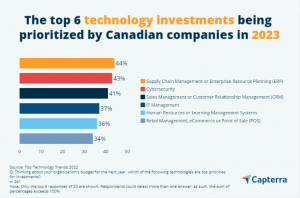Facing rising prices and labour shortages, Canadian businesses are thinking digital: they plan to invest more in tech over the next year in the face of other expected challenges and opportunities for growth.
More than half (56 per cent) of Canadian businesses plan to increase their budget for technology and software purchases as much as 20 per cent over last year; another 12 per cent of companies say they will up their tech spend even more than that. In a challenging economic climate, that is a tough commitment to keep, so government assistance may help.
Cybersecurity software is always a good tech investment, but nowadays prioritized solutions include supply chain management software and human resource management tools.

More than half of Canadian businesses plan to increase their budget for technology and software purchases as much as 20 per cent over last year, a Capterra survey has revealed.
In a survey of some 250 Canadian business leaders, Canada’s digital adoption strategies and activities were compared to other countries, along with actual budgets and purchase plans. Capterra, an online marketplace vendor for the software industry, conducted the survey late last year by contacting hundreds of small business leaders in Canada, the U.S. and U.K., as well as France and Australia, to ask about the technology investments small businesses are making and the drivers and challenges that influence their decisions. A wide range of companies, in terms of revenue and staff size as well as industry sector, were among the respondents.
“Businesses have been hit with a lot of challenges over the last three years, and they’re learning from their experiences,” said Tessa Anaya, analyst for the study. “Many decision-makers have turned to technology and software to combat issues like the labour shortage or supply chain breakdown, while reaping additional benefits like improved productivity and efficiency. Though digital tools are great for smoothing out processes, challenges can arise from their use: be sure to engage and train employees during implementation.”
In addition to cybersecurity and supply chain issues, Canadian SMEs identified other challenges they expect to face in the coming year:
- Engaging customers online in a meaningful way
- Managing projects efficiently and effectively
- Ongoing impact from the COVID-19 pandemic
But labour shortages loom large here and elsewhere as a significant business challenge now. Companies that struggle with the labour shortage report negative impacts such as employees’ growing workloads and declining morale, revenue and profitability losses, and drastic changes to business plans.
As the national labour shortage continues, not only finding new employees but retaining current employees is an obstacle for many Canadian businesses: more than a third (38 per cent) say such problems had affected their business.
As a result, more than a third of respondents plan to invest in HR systems in the coming year, and to advertise jobs on new platforms or in new ways. Business owners know that successful recruiting during a labour shortage requires reaching as wide a pool of candidates as possible. Open positions should be advertised on a variety of platforms, not only on the company website. Using new tech tools like job board software, talent seekers can advertise internally and externally, including on social media websites, while also keeping track of submitted resumes and hiring success rates.
Upskilling employees using technology is a related area of growth potential. Digital innovations affect pretty much every company and every employee these days, and while technology has taken away many jobs, there are many jobs requiring new skills. Finding and developing people with digital business skills is not just a priority in IT, but across the organization.
So with a tight labour market impacting the hiring and developing of employees, with inflationary pressures and supply chain bottlenecks driving prices ever higher, with a subsequent reduction in the revenues and profitability of many companies, where might the resources be found to make the needed or anticipated investments in software and technology?
More than half of Canadian SMEs seek government aid in order to achieve their digital adoption goals. Capterra’s survey revealed that, on a global scale, Canadians are more likely to be both aware and interested in the government grants available to them.
That helps fuel a slightly higher tech adoption rate here in Canada. In general, Canadian businesses plan to invest slightly more in tech than the global average (56 vs. 53 per cent), and it is possible they will be supported by the Canada Digital Adoption Program (CDAP).
CDAP is a mechanism that lets Canadian small- and medium-sized enterprises assess their digital readiness and apply for grants and loans online if found lacking. Funding is available to help eligible companies leverage e-commerce opportunities, upgrade or adopt digital technologies, and digitize their operations to stay competitive and meet their customers’ needs in the digital marketplace.
# # #

Facing rising prices and labour shortages, Canadian businesses are thinking digital: they plan to invest more in tech over the next year in the face of other expected challenges and opportunities for growth. Creative Commons CC0 1.0 Universal Public Domain Dedication Image.
-30-



